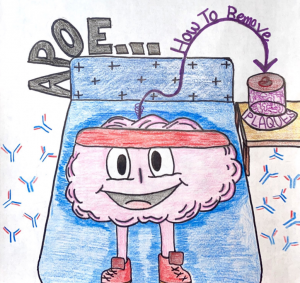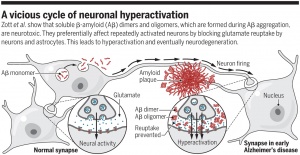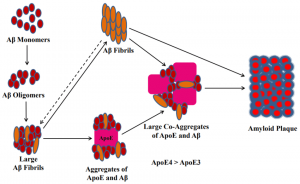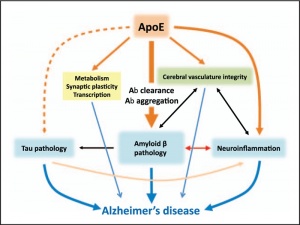 We’ve spoken quite a bit about the impacts that amyloid plaque can have on the anatomy of our brains, and subsequently how those changes in anatomy can have negative effects on our cognitive function. But in case you forgot I will provide a brief overview. Plaques accumulate over time naturally, however, in Alzheimer’s our brain fails to keep up with the demand for clearance and is therefore overwhelmed by the buildup of these plaques. The abnormal levels of these plaques clump together and are found positioned between neurons, ultimately disrupting cellular function as shown below (U.S. Department of Health and Human Services).
We’ve spoken quite a bit about the impacts that amyloid plaque can have on the anatomy of our brains, and subsequently how those changes in anatomy can have negative effects on our cognitive function. But in case you forgot I will provide a brief overview. Plaques accumulate over time naturally, however, in Alzheimer’s our brain fails to keep up with the demand for clearance and is therefore overwhelmed by the buildup of these plaques. The abnormal levels of these plaques clump together and are found positioned between neurons, ultimately disrupting cellular function as shown below (U.S. Department of Health and Human Services).

Consider for a moment that we could simply remove these plaques, it may not solve our problem entirely but perhaps it could lead to a decrease in negative symptoms momentarily. Lucky for us the advancement of technology has provided new techniques to not only decrease amyloid plaque formation initially, but to potentially remove it from an area entirely after is has begun to accumulate.
It might be helpful to first provide some background information that is required to understand the topic. Embedded within an amyloid plaque lies a protein called APOE. APOE is located near the center of the amyloid-APOE complex and is accessible from the exterior given the right circumstances. These complexes come together with AB Fibrils, proteins that are initially soluble but become insoluble after their assembly is altered, this combination is what forms the amyloid plaques that we are so used to talking about. You can see this without my poor explanation in the figure shown below.

Changes in APOE proteins are thought to be one of the largest risk factors for Alzheimer’s, different unnatural changes to the protein can lead to differing severities of the disease. The figure below demonstrates the negative side effects that can come from the unnatural variations of APOE.

Researchers at Washington University recently discovered antibodies that can target and initiate removal of plaques from the brain by directly binding to the APOE domains. By doing this the antibodies effectively flag the compound for degradation by the local immune system. Although it is meant to be a humorous take on the immune systems response to APOE, the picture that I altered may help you remember this point.

When these immune cells target the APOE, scientists discovered that the immune cells would also carry away the connected amyloid plaque that had formed around the APOE. In this situation you can think of the APOE-plaque complex as the metaphorical saying “throwing the baby out with the bathwater,” except in this case it’s a positive.

It should be noted however, that there is a caveat to this claim relating to the removal of plaques via antibody binding. Scientists believe that using antibodies may only be effective during the early stages of amyloid plaque build-up. The scientists from Washington noted that if too much plaque is present, that the addition of antibodies might not be enough to counteract the inevitable disease that is Alzheimer’s.
“Okay,” you might say, “but surely APOE has other important roles in the body, degrading all of it would be bad.” And indeed you would be right, APOE does have other important roles in the body such as “the transfer of cholesterol and phospholipid between cells” (Liao et al, 2017). Luckily however, researchers found an antibody that only affects the APOE in the brain and not throughout the rest of the body. Initially the researchers were stumped as to why the antibody (antibody HAE-4) only affected the APOE in the brain. But of course, someone else had done their research for them, it turns out that there are three different naturally occurring isoforms of APOE. Different isoforms are present depending on the region of the body, the brain having its own individual isoform entirely (from what I gathered from the article). This difference allows antibodies, and therefore researchers, to target the brain’s APOE without worrying about damaging the subject. Because of this discrepancy, researchers can potentially use antibody technology to prevent Alzheimer’s disease in the future.
Sources
Liao, F., Yoon, H., & Kim, J. (2017, February). Apolipoprotein E metabolism and functions in brain and its role in Alzheimer’s disease. Current opinion in lipidology. Retrieved September 27, 2021, from https://www.ncbi.nlm.nih.gov/pmc/articles/PMC5213812/.
ScienceDaily. (2018, March 26). Antibody removes alzheimer’s plaques, in mice. ScienceDaily. Retrieved September 27, 2021, from https://www.sciencedaily.com/releases/2018/03/180326161000.htm.
U.S. Department of Health and Human Services. (n.d.). What happens to the brain in alzheimer’s disease? National Institute on Aging. Retrieved September 27, 2021, from https://www.nia.nih.gov/health/what-happens-brain-alzheimers-disease.